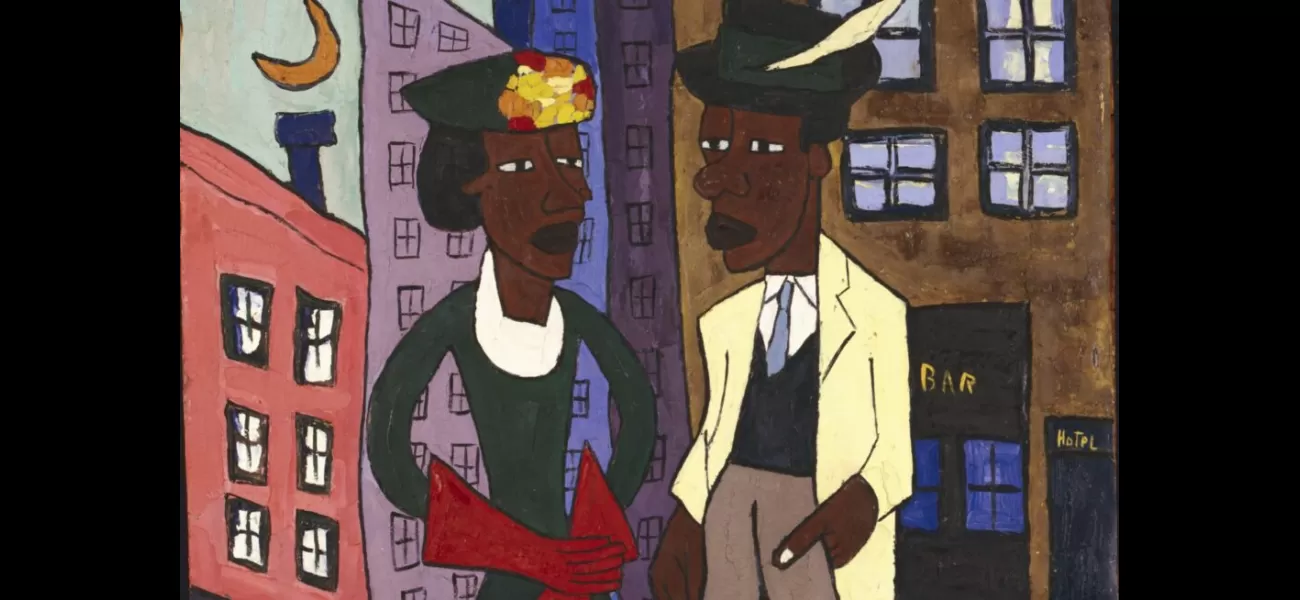The Met's 'Harlem Renaissance and Transatlantic Modernism' exhibit is highlighting its blackest moment.
An homage to Alain Locke, the Harlem Renaissance and Transatlantic Modernism intertwine.
February 25th 2024.

The Metropolitan Museum of Art is showcasing a significant moment in American history and art with its latest exhibition, The Harlem Renaissance and Transatlantic Modernism. This exhibition is a much-needed redemption for the institution, as it has been 55 years since it last displayed a major exhibition focused on Black culture. The previous exhibit, Harlem on My Mind: Cultural Capital of Black America, 1900—1968, received criticism for not featuring any actual artwork. However, this time around, The Met has enlisted the support of the Ford Foundation, the Barrie A. and Deedee Wigmore Foundation, and Denise Littlefield Sobel to curate a diverse collection of paintings, sculptures, films, and photographs that truly capture the essence of the Harlem Renaissance.
In a press statement, Ford Foundation president Darren Walker praised the exhibition, stating, "This landmark exhibition celebrates the brilliant and talented artists behind the groundbreaking cultural movement we now know as the Harlem Renaissance." He also commended the Met and curator Denise Murrell for their vision and thoughtful curation of the exhibition, which offers a powerful glimpse into the Black experience during the early 20th century.
The Harlem Renaissance and Transatlantic Modernism pays tribute to philosopher Alain Locke and his rejection of stereotypical depictions of Blackness that were prevalent in white America at the time. Instead, Locke championed the amplification of Black art and excellence, embracing the complexity and diversity of the Black experience. Murrell shares this interest in reviving "autonomous Black self-expression" from the era. The exhibition features 160 works from notable artists such as James Van Der Zee, Aaron Douglas, James Weldon Johnson, Charles S. Johnson, Langston Hughes, and lesser-known artists like Laura Wheeler Waring.
BLACK ENTERPRISE had the opportunity to speak with Murrell about her curation of The Harlem Renaissance and Transatlantic Modernism. She explained that the exhibition begins with portraits of influential thinkers who were in conversation with Alain Locke and his philosophy. One notable portrait is of writer and anthropologist Zora Neal Hurston by Aaron Douglas, a leading artist of the Harlem Renaissance. Murrell also emphasizes the importance of including works from historical Black colleges and universities, such as the loaned portrait of Hurston from Fisk University.
When asked about her decision to include non-African American artists in a show about Black art and expression, Murrell explains that Alain Locke believed the movement should be led by African Americans but not exclusive to them. He recognized the contributions of West African Caribbean writers, artists, dancers, and performers to the Harlem Renaissance. Additionally, Locke believed that European artists who incorporated African aesthetics and created modern, non-stereotypical portrayals of Black subjects could be considered part of the same movement. Murrell's curation reflects this perspective, and many of the European artists featured were praised by Locke for their work.
The history of the Harlem Renaissance is vast, and the same can be said for its art history. Murrell faced the challenge of narrowing down the artists to be featured in the exhibition. She received guidance from an advisory committee, including Mary Schmidt Campbell, the former president of Spelman College and director of the Studio Museum in Harlem. Other scholars and experts also provided input, and Murrell consulted period publications, such as covers of Crisis, the NAACP and Urban League's publications, and the Harmon Foundation and HBCU's materials, to ensure a comprehensive representation of the era.
The Harlem Renaissance and Transatlantic Modernism is a celebration of a pivotal moment in American history and art. It showcases the diversity and brilliance of Black artists, as well as the influence of other cultures and perspectives. This exhibition not only honors the legacy of the Harlem Renaissance but also sheds light on the ongoing struggle for Black self-expression and representation. It is a must-see for anyone interested in the intersection of art, culture, and history.
The Metropolitan Museum of Art is proud to present a new exhibition that delves into the rich history and art of the Harlem Renaissance, a pivotal movement in American culture. Titled "The Harlem Renaissance and Transatlantic Modernism," this exhibition is a tribute to the talented and groundbreaking artists who shaped the cultural landscape of Black America from 1900 to 1968.
This exhibition is a significant moment for the Met, as it marks the first time in 55 years that they have featured a comprehensive exhibition on the Harlem Renaissance. The previous exhibition, "Harlem on My Mind: Cultural Capital of Black America, 1900-1968," did not include any works of art. However, with the support of the Ford Foundation, the Barrie A. and Deedee Wigmore Foundation, and Denise Littlefield Sobel, the Met has redeemed itself with this thoughtfully curated collection, curated by Denise Murrell, the Merryl H. and James S. Tisch Curator at Large.
In a statement to the press, Darren Walker, president of the Ford Foundation, expressed his excitement for the exhibition, stating, "This landmark exhibition celebrates the brilliant and talented artists behind the groundbreaking cultural movement we now know as the Harlem Renaissance. I thank the dedicated team at The Met and applaud Denise Murrell for her vision and thoughtful curation of this vibrant collection of paintings, sculptures, film, and photography that gives a powerful glimpse into the Black experience in the early 20th century."
The Harlem Renaissance and Transatlantic Modernism pays homage to philosopher Alain Locke and his rejection of stereotypical Blackness in favor of celebrating the complexity and excellence of Black art. Murrell, like Locke, aims to revive the concept of "autonomous Black self-expression" during this time. The exhibition features 160 works from notable artists such as James Van Der Zee, Aaron Douglas, James Weldon Johnson, Charles S. Johnson, Langston Hughes, and lesser-known artists like Laura Wheeler Waring, to name a few.
BLACK ENTERPRISE had the opportunity to speak with Murrell about her curation of the exhibition and the significance of the Harlem Renaissance and Transatlantic Modernism. Murrell explained that the show begins with portraits of influential thinkers who were in conversation with each other and Locke's philosophy. One notable portrait is of Zora Neal Hurston, a renowned writer, by Aaron Douglas, one of the leading artists of the Harlem Renaissance. Murrell also highlights the importance of including loans from historical Black colleges and universities, such as the loan of Hurston's portrait from Fisk University.
When asked about the decision to include non-African American artists in an exhibition about Black art and expression, Murrell shared that Locke believed in the inclusivity of the movement, stating, "He believed that if an artist like Picasso was working with African aesthetics and portraying Black European subjects in a modern and dignified manner, then they were all part of the same movement." Murrell also notes that many of the European artists featured in the exhibition were named by Locke himself as artists who were worthy of admiration for their modern and dignified portrayals of Black subjects.
The Harlem Renaissance was a significant moment in American history, and its art history is just as epic in proportion. Murrell admits that narrowing down the artists to be featured was a challenge, but she had the guidance of an advisory committee that included notable scholars and experts in the field. This included Mary Schmidt Campbell, former president of Spelman College and curator of the 1987 Studio Museum in Harlem show, the last major exhibition on the Harlem Renaissance in New York City. Murrell also consulted period publications, such as the covers of Crisis, NAACP and Urban League's publications, and the Harmon Foundation and HBCUs.
In conclusion, "The Harlem Renaissance and Transatlantic Modernism" is a must-see exhibition that celebrates the vibrant and diverse art of the Harlem Renaissance. It is a testament to the resilience and creativity of Black artists during a pivotal moment in American history. The Met has once again proven its commitment to showcasing diverse and important voices in the art world, and Murrell's thoughtful curation brings new insights and perspectives to this iconic movement.
In a press statement, Ford Foundation president Darren Walker praised the exhibition, stating, "This landmark exhibition celebrates the brilliant and talented artists behind the groundbreaking cultural movement we now know as the Harlem Renaissance." He also commended the Met and curator Denise Murrell for their vision and thoughtful curation of the exhibition, which offers a powerful glimpse into the Black experience during the early 20th century.
The Harlem Renaissance and Transatlantic Modernism pays tribute to philosopher Alain Locke and his rejection of stereotypical depictions of Blackness that were prevalent in white America at the time. Instead, Locke championed the amplification of Black art and excellence, embracing the complexity and diversity of the Black experience. Murrell shares this interest in reviving "autonomous Black self-expression" from the era. The exhibition features 160 works from notable artists such as James Van Der Zee, Aaron Douglas, James Weldon Johnson, Charles S. Johnson, Langston Hughes, and lesser-known artists like Laura Wheeler Waring.
BLACK ENTERPRISE had the opportunity to speak with Murrell about her curation of The Harlem Renaissance and Transatlantic Modernism. She explained that the exhibition begins with portraits of influential thinkers who were in conversation with Alain Locke and his philosophy. One notable portrait is of writer and anthropologist Zora Neal Hurston by Aaron Douglas, a leading artist of the Harlem Renaissance. Murrell also emphasizes the importance of including works from historical Black colleges and universities, such as the loaned portrait of Hurston from Fisk University.
When asked about her decision to include non-African American artists in a show about Black art and expression, Murrell explains that Alain Locke believed the movement should be led by African Americans but not exclusive to them. He recognized the contributions of West African Caribbean writers, artists, dancers, and performers to the Harlem Renaissance. Additionally, Locke believed that European artists who incorporated African aesthetics and created modern, non-stereotypical portrayals of Black subjects could be considered part of the same movement. Murrell's curation reflects this perspective, and many of the European artists featured were praised by Locke for their work.
The history of the Harlem Renaissance is vast, and the same can be said for its art history. Murrell faced the challenge of narrowing down the artists to be featured in the exhibition. She received guidance from an advisory committee, including Mary Schmidt Campbell, the former president of Spelman College and director of the Studio Museum in Harlem. Other scholars and experts also provided input, and Murrell consulted period publications, such as covers of Crisis, the NAACP and Urban League's publications, and the Harmon Foundation and HBCU's materials, to ensure a comprehensive representation of the era.
The Harlem Renaissance and Transatlantic Modernism is a celebration of a pivotal moment in American history and art. It showcases the diversity and brilliance of Black artists, as well as the influence of other cultures and perspectives. This exhibition not only honors the legacy of the Harlem Renaissance but also sheds light on the ongoing struggle for Black self-expression and representation. It is a must-see for anyone interested in the intersection of art, culture, and history.
The Metropolitan Museum of Art is proud to present a new exhibition that delves into the rich history and art of the Harlem Renaissance, a pivotal movement in American culture. Titled "The Harlem Renaissance and Transatlantic Modernism," this exhibition is a tribute to the talented and groundbreaking artists who shaped the cultural landscape of Black America from 1900 to 1968.
This exhibition is a significant moment for the Met, as it marks the first time in 55 years that they have featured a comprehensive exhibition on the Harlem Renaissance. The previous exhibition, "Harlem on My Mind: Cultural Capital of Black America, 1900-1968," did not include any works of art. However, with the support of the Ford Foundation, the Barrie A. and Deedee Wigmore Foundation, and Denise Littlefield Sobel, the Met has redeemed itself with this thoughtfully curated collection, curated by Denise Murrell, the Merryl H. and James S. Tisch Curator at Large.
In a statement to the press, Darren Walker, president of the Ford Foundation, expressed his excitement for the exhibition, stating, "This landmark exhibition celebrates the brilliant and talented artists behind the groundbreaking cultural movement we now know as the Harlem Renaissance. I thank the dedicated team at The Met and applaud Denise Murrell for her vision and thoughtful curation of this vibrant collection of paintings, sculptures, film, and photography that gives a powerful glimpse into the Black experience in the early 20th century."
The Harlem Renaissance and Transatlantic Modernism pays homage to philosopher Alain Locke and his rejection of stereotypical Blackness in favor of celebrating the complexity and excellence of Black art. Murrell, like Locke, aims to revive the concept of "autonomous Black self-expression" during this time. The exhibition features 160 works from notable artists such as James Van Der Zee, Aaron Douglas, James Weldon Johnson, Charles S. Johnson, Langston Hughes, and lesser-known artists like Laura Wheeler Waring, to name a few.
BLACK ENTERPRISE had the opportunity to speak with Murrell about her curation of the exhibition and the significance of the Harlem Renaissance and Transatlantic Modernism. Murrell explained that the show begins with portraits of influential thinkers who were in conversation with each other and Locke's philosophy. One notable portrait is of Zora Neal Hurston, a renowned writer, by Aaron Douglas, one of the leading artists of the Harlem Renaissance. Murrell also highlights the importance of including loans from historical Black colleges and universities, such as the loan of Hurston's portrait from Fisk University.
When asked about the decision to include non-African American artists in an exhibition about Black art and expression, Murrell shared that Locke believed in the inclusivity of the movement, stating, "He believed that if an artist like Picasso was working with African aesthetics and portraying Black European subjects in a modern and dignified manner, then they were all part of the same movement." Murrell also notes that many of the European artists featured in the exhibition were named by Locke himself as artists who were worthy of admiration for their modern and dignified portrayals of Black subjects.
The Harlem Renaissance was a significant moment in American history, and its art history is just as epic in proportion. Murrell admits that narrowing down the artists to be featured was a challenge, but she had the guidance of an advisory committee that included notable scholars and experts in the field. This included Mary Schmidt Campbell, former president of Spelman College and curator of the 1987 Studio Museum in Harlem show, the last major exhibition on the Harlem Renaissance in New York City. Murrell also consulted period publications, such as the covers of Crisis, NAACP and Urban League's publications, and the Harmon Foundation and HBCUs.
In conclusion, "The Harlem Renaissance and Transatlantic Modernism" is a must-see exhibition that celebrates the vibrant and diverse art of the Harlem Renaissance. It is a testament to the resilience and creativity of Black artists during a pivotal moment in American history. The Met has once again proven its commitment to showcasing diverse and important voices in the art world, and Murrell's thoughtful curation brings new insights and perspectives to this iconic movement.
[This article has been trending online recently and has been generated with AI. Your feed is customized.]
[Generative AI is experimental.]
0
0
Submit Comment





